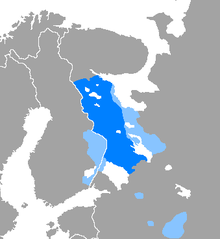Karelian language
| Karelian | |
|---|---|
| karjal kariela karjala |
|
| Native to | Russia, Finland |
| Region | Republic of Karelia, Tver Oblast |
| Ethnicity | Karelians |
|
Native speakers
|
36,000 (1994–2010) |
| Latin (Karelian alphabet) Cyrilic (Russia) | |
| Official status | |
|
Recognised minority
language in |
|
| Language codes | |
| ISO 639-2 | |
| ISO 639-3 | |
| Glottolog | kare1335 |
 |
|
Karelian language (karjala, karjal or kariela) is a Finnic language spoken mainly in the Russian Republic of Karelia. Linguistically Karelian is closely related to the Finnish dialects spoken in eastern Finland and some Finnish linguists even classified Karelian as a dialect of Finnish. Karelian is not to be confused with the Southeastern dialects of Finnish, sometimes referred to as karjalaismurteet ('Karelian dialects') in Finland.
There is no single standard Karelian language. Each writer writes in Karelian according to their own dialectal form. Three main written standards have been developed, for North Karelian; Olonets Karelian; and Tver Karelian. All variants are written with the Latin-based Karelian alphabet, though the Cyrillic script has been used in the past.
The Karelian language belongs to the Finnic branch of the Uralic languages, and it is closely related to Finnish. Finnish and Karelian have common ancestry in the Proto-Karelian language spoken in the coast of Lake Ladoga in the Iron Age and Karelian forms a dialect continuum with the Eastern dialects of Finnish. Earlier some Finnish linguists classified Karelian as a dialect of Finnish, sometimes known in older Finnish literature as Raja-Karjalan murteet ('Border Karelian dialects'), but today Karelian is seen as a distinct language. Besides Karelian and Finnish, the Finnic subgroup also includes Estonian and some minority languages spoken around the Baltic Sea.
Karelian is spoken by about 100,000 people, mainly in the Republic of Karelia, Russia although notable Karelian-speaking communities can also be found in the Tver region northwest of Moscow. Previously, it was estimated that there were 5,000 speakers in Finland, mainly belonging to the older generations, but more recent estimates have increased that number to 30,000. Due to post-World War II mobility and internal migration, Karelians now live scattered throughout Finland, and Karelian is no longer spoken as a local community language.
...
Wikipedia
